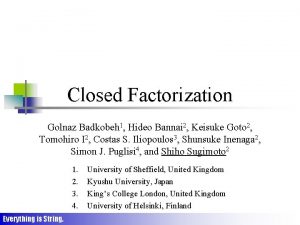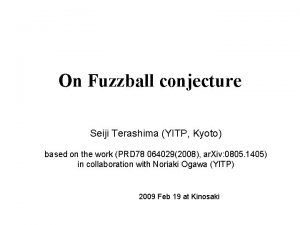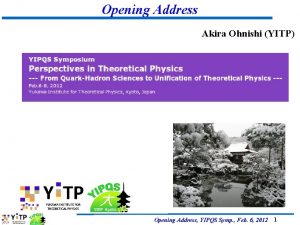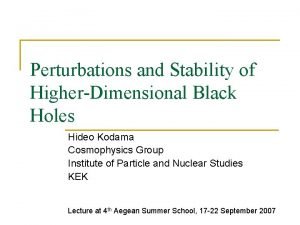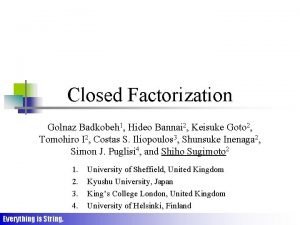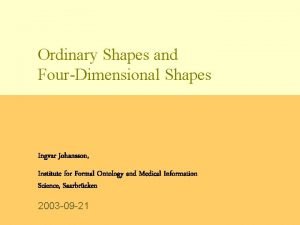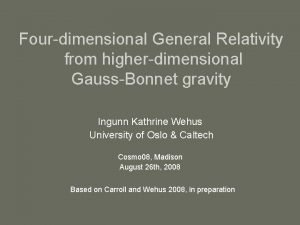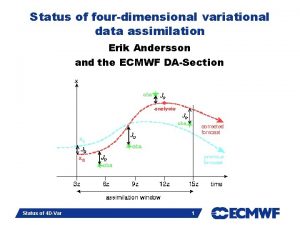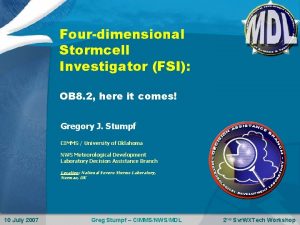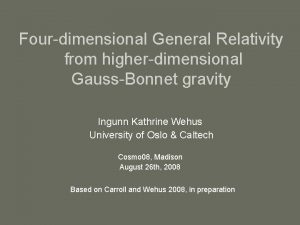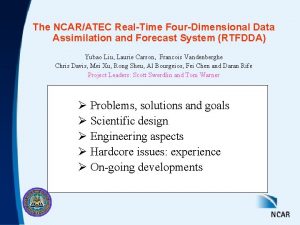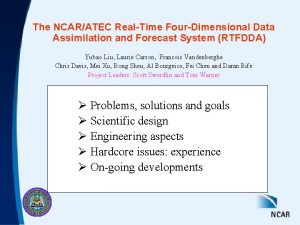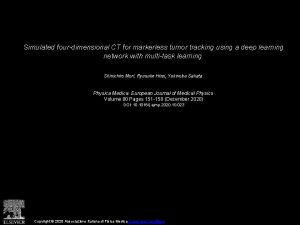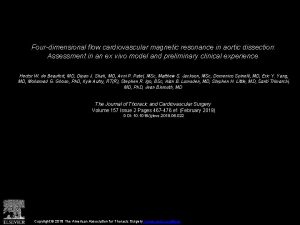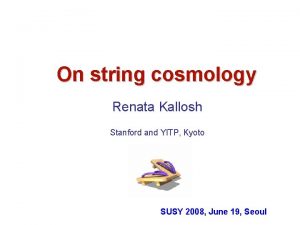Is the fourdimensional effective theory effective YITP Hideo






















![5 -dim 4 -dim CCGLP-type solution [Chen et al (2005), Kodama & Uzawa(2005)] Under 5 -dim 4 -dim CCGLP-type solution [Chen et al (2005), Kodama & Uzawa(2005)] Under](https://slidetodoc.com/presentation_image/5b063cc741f14d2e5e5674e6ee8e55c1/image-23.jpg)



![Cf. Arroja and Koyama [hep-th/0602068] argued that this conclusion is not correct at least Cf. Arroja and Koyama [hep-th/0602068] argued that this conclusion is not correct at least](https://slidetodoc.com/presentation_image/5b063cc741f14d2e5e5674e6ee8e55c1/image-27.jpg)
- Slides: 27

Is the four-dimensional effective theory effective? YITP Hideo Kodama HK and Kunihito Uzawa, JHEP 0507: 061(2005) HK and Kunihito Uzawa, hep-th/0512104

Three Major Requirements on HUT 4 -dimensional universe at present compactification of the extra dimension moduli stabilisation

Moduli Stabilisation Compactification without flux In this case, D=11/10 sugra reduces to a theory for gravity coupled with dilaton. Assume Then In the cosmological context, the second equation leads to

Flux compactification Moduli for IIB Sugra Shape moduli ⇒ τ, the complex structure J of CY: Size moduli ⇒ Kahler moduli of CY: 4 D effective action (tree) [Gukov, Vafa & Witten (2000)]

Discrete set of vacua For τ=const, Hence, W depends only on the cohomology classes of 3 -form fluxes: Stabilisation of all shape moduli This privides constraints. [Giddings, Kachru & Polchinski(2002)] No scale model Because W is independent of ρ and DW=d. W + d. K W , we have The size modulus ρ is not stabilised.

Three Major Requirements on HUT 4 -dimensional universe at present compactification of the extra dimension moduli stabilisation Realistic low energy physics gauge/generation structure, symmetry breaking, … Primordial inflation and dark energy violation of strong energy condition

Obstructions against inflation No de Sitter SUSY vacuum No-Go theorem against accelerated cosmic expansion Assume • The spacetime metric is of the warped product type • The internal space is static and compact without boundary. • The warp factor is regular and bounded everywhere. • The strong energy condition is satisfied in the full theory. Then, no accelerated expansion is allowed for the four-dimensional spacetime Proof

KKLT Construction (2003) Stabilisation of the volume modulus When there exists a special 4 -cycle Z on Y • Euclidean D 3 -brane wrapped on Z ⇒ • D 7 brane wrapped on Z ⇒ gaugino condensate ⇒ Combining with the no scale model ⇒ Stable supersymmetric Ad. S vacuum with all moduli fixed Uplifting the vacuum Adding N anti-D 3 branes at the KS throat Adjusting the number of anti-D 3 branes ⇒ (Metastable) d. S vacuum

Difficulties Non-genericity of the size modulus stabilisation KKLT construction: Instanton effects ⇒ Kaehler moduli stabilisation The volume modulus is not stabilised in a model with a single Kaeher modulus [Denef, Douglas and Florea 2004] There exist models in which all Kaehler moduli are stabilsed by the instanton effects, but they are not generic [Denef et al 2005, Aspinwall & Kallosh 2005] Fluxes produce warped geometry Warped structure is not taken into account in the volume modulus stabilisation argument. The orbifold singularity with negative charge In order to evade the No-Go theorem, singular objects or branes/orientifold planes with negative tension are required. These singular objects produce naked singularities in classical supergravity, which may not be resolved in quantum theory.

Warped Compactification

Flux Produces Warp Einstein Equations If is y-dependent. Hence, the 4 D metric depends not only on x but also on the internal coordinate y. Warped Geometry In order to preserve some supersymmetry, we assume that the metric takes the warped product form

Conifold compactification When Y is Ricci flat, the 3 -form flux vanishes and the 5 -form flux takes the form the field equations are reduced to For example, for the 5 -form flux produced by D 3 branes with flat X, we obtain a regular spacetime with full SUSY: Note that when D 3 branes and anti-D 3 branes coexist, naked singularities appear, because

Klebanov-Strassler solution Constant τ, 5 -form flux and ISD 3 -form flux CY=deformed conifold regular at r=0 Then we have Compactification of this solution was discussed by Giddings, Kachru and Polchinski (2002)

Size Moduli Dynamics Assumptions – – – Metric All moduli except for the size modulus are stabilised Form fields General solution [Kodama & Uzawa, JHEP 0507: 061(2005)] If and the metric has no null Killing where proof

Implications The size modulus is still unstable even if warp is taken into account and is associated with full SUSY breaking of the order However, when the volume modulus is x-dependent, the xdependent part does not factor out from the warp factor as is assumed in most effective four-dimensional theories. The concept of the Einstein frame loses meaning, . In a strongly warped region where is large as at the KS throat, the volume modulus can be effectively stabilised for a long time. Hence, if we live in a brane at a deep KS throat, all moduli can be stabilised and SUSY is preserved for a sufficiently long time, even without quantum stabilisation effects. When the instability grows, it produces a Big-Rip singularity if a<0. [cf. Gibbons, Lu & Pope(2005)].

Cosmology Orders Naked Singularities In order to get a solution with compact and closed Y, we have to introduce some singular sources, such as the orientifold O 3 with negative charge, in order to cancel the negative term in the righthand side of the equation in accordance to the No-Go theorem (the tadpole condition). Such a source gives rise to a singular negative contribution to the warp factor h in general. Hence, in order to realise the moduli stabilisation and the inflation, we have to allow for the existence of naked singularities in the classical limit. Cf. IIA moduli stabilisation [De. Wolfe, Giryavets, Kachru & Taylor 2005]

Four-Dimensional Effective Theories

No Flux Case Assumptions The 10 D metric has the form All moduli except for the size modulus are stabilised No flux Effective action

Characteristic Features This effetive 4 -dim theory is equivalent to the original 10 -dim theory under the above ansatz. For , the effective action is invariant under the trasformation in the Einstein frame: The solution in which h increases with the cosmic expandion: The solution in which h decreases with the cosmic expansion. . We will see that only the first decompactifying solution survives in the warped compactification.

IIB Supergravity with Flux Ansatz on 10 -dim IIB Fields Metric: Dilaton : Gauge fields: Warp factor:

Effective Action The effective action for 4 -dim fields given by and is where Characteristic Features The 4 -dim effective action has the same form as that in the no-flux case. In particular, the effecitve 4 -dim theory has the modular invariance in the “Einstein frame” that is not respected in the original 10 -dim theory:

Heterotic M Theory 11 -dim 5 -dim Ansatz Field equations 5 -dim effective action
![5 dim 4 dim CCGLPtype solution Chen et al 2005 Kodama Uzawa2005 Under 5 -dim 4 -dim CCGLP-type solution [Chen et al (2005), Kodama & Uzawa(2005)] Under](https://slidetodoc.com/presentation_image/5b063cc741f14d2e5e5674e6ee8e55c1/image-23.jpg)
5 -dim 4 -dim CCGLP-type solution [Chen et al (2005), Kodama & Uzawa(2005)] Under the ansatz the general solution is given by From this it follows that 4 -dim effective action

Summary and Discussions

Size Modulus Instability For warped compactifications in the type IIB sugra and the heterotic M theory In the classical sugra framework, the size modulus is unstable even for the warped compactification with flux. The instability mode produces an x-dependent additive correction to the warp factor as. In particular, the instability is effectively suppressed in a strongly warped region. This instability can be stabilised only by quantum effects or other corrections to sugra in higher dimensions.

4 -dim effective theory We can construct an effective 4 -dim theory for the metric and the size modulus that reproduces the instability in the original theory. The effective theories obtained in this way for warped compactification are identical to that in the no warp case. In particular, the effective theory allows a wider class of solutions than the original higherdimensional theory under the ansatz used to obtain the 4 -dim effective theory.
![Cf Arroja and Koyama hepth0602068 argued that this conclusion is not correct at least Cf. Arroja and Koyama [hep-th/0602068] argued that this conclusion is not correct at least](https://slidetodoc.com/presentation_image/5b063cc741f14d2e5e5674e6ee8e55c1/image-27.jpg)
Cf. Arroja and Koyama [hep-th/0602068] argued that this conclusion is not correct at least in the 5 -dim HW theory, by showing that any solution to the effective 4 -dim theory can be uplifted to a 5 -dim solution by the gradient expansion method up to the first order, if the ansatz on the 5 -dim metric is modified to include a slightly wider class. Answer to this critique is They have not shown that the uplifting is possible in the full order. Our argument in the IIB case is much more general, and it does not seem possible to construct uplifting of 4 dim solutions by simple modification of the ansatz. If we do not impose any ansatz on the higherdimensional configurations, it is always possible to find some uplifting of 4 -dim solutions, but uplifting is far from unique. The essential point is to find a good ansatz on higher-dimensional solutions.
 Golnaz badkobeh
Golnaz badkobeh Yitp kyoto
Yitp kyoto Yitp
Yitp Hình ảnh bộ gõ cơ thể búng tay
Hình ảnh bộ gõ cơ thể búng tay Lp html
Lp html Bổ thể
Bổ thể Tỉ lệ cơ thể trẻ em
Tỉ lệ cơ thể trẻ em Voi kéo gỗ như thế nào
Voi kéo gỗ như thế nào Tư thế worm breton là gì
Tư thế worm breton là gì Chúa sống lại
Chúa sống lại Các môn thể thao bắt đầu bằng từ đua
Các môn thể thao bắt đầu bằng từ đua Thế nào là hệ số cao nhất
Thế nào là hệ số cao nhất Các châu lục và đại dương trên thế giới
Các châu lục và đại dương trên thế giới Công thức tính độ biến thiên đông lượng
Công thức tính độ biến thiên đông lượng Trời xanh đây là của chúng ta thể thơ
Trời xanh đây là của chúng ta thể thơ Cách giải mật thư tọa độ
Cách giải mật thư tọa độ Làm thế nào để 102-1=99
Làm thế nào để 102-1=99 Phản ứng thế ankan
Phản ứng thế ankan Các châu lục và đại dương trên thế giới
Các châu lục và đại dương trên thế giới Thơ thất ngôn tứ tuyệt đường luật
Thơ thất ngôn tứ tuyệt đường luật Quá trình desamine hóa có thể tạo ra
Quá trình desamine hóa có thể tạo ra Một số thể thơ truyền thống
Một số thể thơ truyền thống Cái miệng xinh xinh thế chỉ nói điều hay thôi
Cái miệng xinh xinh thế chỉ nói điều hay thôi Vẽ hình chiếu vuông góc của vật thể sau
Vẽ hình chiếu vuông góc của vật thể sau Thế nào là sự mỏi cơ
Thế nào là sự mỏi cơ đặc điểm cơ thể của người tối cổ
đặc điểm cơ thể của người tối cổ V cc cc
V cc cc Vẽ hình chiếu đứng bằng cạnh của vật thể
Vẽ hình chiếu đứng bằng cạnh của vật thể
